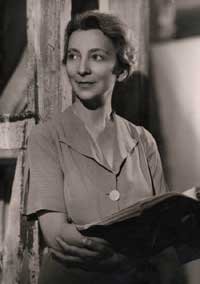Leontine Sagan
| Leontine Sagan | |
|---|---|
 | |
| Born |
Leontine Schlesinger February 13, 1889 Budapest or Vienna, Austria-Hungary |
| Died |
May 20, 1974 (aged 85) Pretoria, South Africa |
| Spouse(s) | Dr. Victor Fleischer |
Leontine Sagan (born Leontine Schlesinger, February 13, 1889 – May 20, 1974) was an Austrian-Hungarian theatre director and actress of Jewish descent.[1] She is most well known for directing Mädchen in Uniform (1931). Along with directing, Sagan also acted in multiple films throughout her lifetime. Sagan died in Pretoria, South Africa in 1974, at the age of 85.[2]
Sagan’s films centered on women, often depicting eroticism. Her films were among the first to suggest lesbian themes.
Personal life
Born in Budapest or Vienna, Sagan trained with Max Reinhardt, who is best known for his elaborate and imaginative sets and theatrics.[3] In her later years, Sagan married Dr. Victor Fleischer.[4]
Career
Sagan directed three films, all of which are notable. She is best remembered for the first of two films she directed, Mädchen in Uniform (1931). It has an all-female cast and was ground-breaking not only for its portrayal of lesbian and pedagogical eros, but also for its co-operative and profit-sharing financial arrangements in the production. Whether Sagan herself was a lesbian is unrecorded;[5] the book Women Film Directors lists her as "lesbian film director" as she directed Christa Winsloe's play, that is said to contain lesbian themes.[6] In her teenage years, she worked as a stage actress in Germany and Austria. Some films that Sagan appeared in include Der helilige Berg (1926), Der grosse Sprung (1927), Der Weiss Rausch (1930), and Die Nacht der Regisseure (1994).[7] It wasn’t until 1931, when Sagan became involved behind the scenes, that she gained international attention after directing her most significant film Mädchen in Uniform. Following the debut of this film, Sagan moved to England.[2] [8] In England, she directed Men of Tomorrow and worked for the film director Alexander Korda at Korda’s Studios.[9] Towards the end of her career, Sagan moved to South Africa and became an influential director in South African theatre. She also co-founded the National Theatre in Johannesburg.[9]
Filmography
*Mädchen in Uniform (1931)
Sagan’s most significant film featured an all-female cast. It was the first film in Germany to be produced cooperatively, where both the crew and cast obtained shares rather than a salary.[10] Mädchen in Uniform is based on the play by Christa Winsloe, survived but was much-censored until the 1970s. Eleanor Roosevelt is credited with helping to revoke its censorship in the US. It has been released in its surviving form on video-tape, with English subtitles, in the US in 1994 and in the UK in 2000. The films centers on an all girls boarding school. It examines various emotional and physical pressures caused by the authoritarian rule and militarism of the Prussian headmistress.[9] The film is among the first to suggest lesbian themes. Throughout Mädchen in Uniform, girls are depicted holding hands, shown dressing and undressing, and in one scene two women are depicted kissing on the lips.[9] The film’s main character Manuela, a 14-year-old girl, develops a crush on her teacher Fräulein von Bernburg, which affects her performance in her class.[9] The film was banned by the Nazis as 'decadent', however it has left a significant mark on history for its female imagery and anti-militaristic themes.[10] In particular, this film was influential at women’s film festivals in the 1970s.[11]
*Men of Tomorrow (1932)
Follows the life of a young Oxford University Student.[9]
* Gaiety George (1946)
Biography of George Edwardes, an Irish stage producer.[9]
Books
- Lights and Shadows: The autobiography of Leontine Sagan, Johannesburg 1996[9]
- Michael Eckardt (ed.): Leontine Sagan. Licht und Schatten. Schauspielerin und Regisseurin auf vier Kontinenten. Hentrich & Hentrich, Berlin 2010, ISBN 978-3-941450-12-7.
Impact on Film
Leontine Sagan was an influential director who was not afraid to go against the grain in the film industry. She was not afraid to express her anti-authoritarian views and to address controversial topics in her films. She not only opened the door for female directors, but also laid the groundwork for the appearance and acceptance of homosexuality in films.
Notes
- ↑ Bernard Sachs. South African Personalities and Places. Kayor Publishers, Johannesburg, 1959. Excerpt
- 1 2 Foster, G. (1998) Women filmmakers & their films (pp. 361-362). Detroit: St. James Press.
- ↑ Reinhardt, Max. (n.d.). Retrieved May 2, 2015, from http://www.anb.org/articles/18/18-03777.html?from=../18/18-03329.html&from_nm=Dietrich, Marlene
- ↑ Foster, G (1998). Women filmmakers & their films (pp. 361-362). Detroit: St. James Press.
- ↑ lespress.de "vermutlich lesbische Regisseurin" (Eng.: "possibly lesbian director")
- ↑ Foster, Gwendolyn Audrey (1995), Women Film Directors: An International Bio-Critical Dictionary, Greenwood Press, p. 322, ISBN 0-313-28972-7.
- ↑ Leontine Sagan. (n.d.). Retrieved May 2, 2015, from http://www.filmdirectorssite.com/leontine-sagan
- ↑ Hitler Comes to Power. (n.d). Retrieved May 8, 2015, from http://www.ushmm.org/outreach/en/article.php?ModuleId=10007671
- 1 2 3 4 5 6 7 8 Foster, G. (1998). Women filmmakers & their films (pp. 361-362). Detroit: St. James Press.
- 1 2 Acker, A. (1991). Reel women: Pioneers of the cinema, 1896 to the present (pp. 320-322). New York: Continuum.
- ↑ Mädchen in Uniform. (n.d.). Retrieved May 2, 2015, from http://www.filmreference.com/Films-Le-Ma/M-dchen-in-Uniform.html
References
- Acker, A. (1991). Reel women: Pioneers of the cinema, 1896 to the present (pp. 320–322). New York: Continuum.
- Bernard Sachs. South African Personalities and Places. Kayor Publishers, Johannesburg, 1959. Excerpt
- Foster, Gwendolyn Audrey (1995), Women Film Directors: An International Bio-Critical Dictionary, Greenwood Press, p. 322, ISBN 0-313-28972-7.
- Foster, G. (1998). Women filmmakers & their films (pp. 361–362). Detroit: St. James Press.
- lespress.de "vermutlich lesbische Regisseurin" (Eng.: "possibly lesbian director")
- Mädchen in Uniform. (n.d.). Retrieved May 2, 2015, from http://www.filmreference.com/Films-Le-Ma/M-dchen-in-Uniform.html